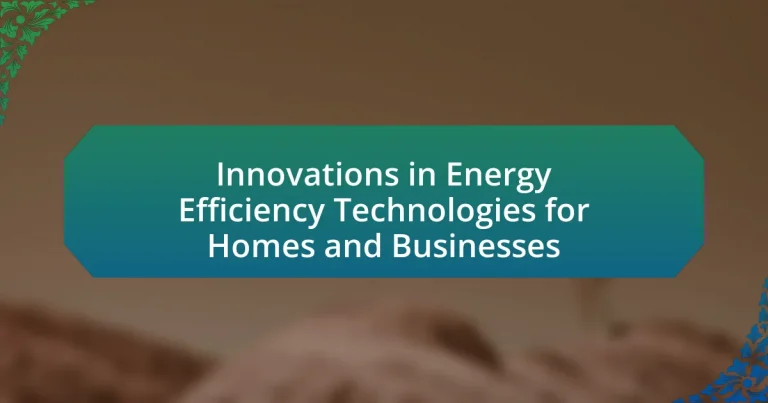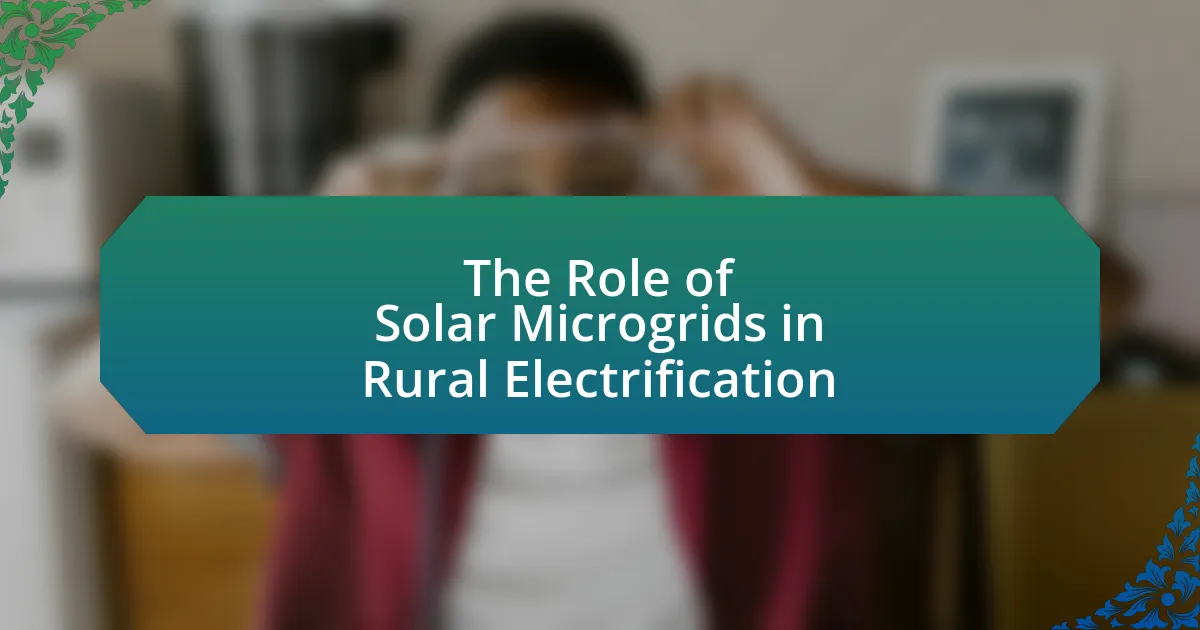Innovations in energy efficiency technologies for homes and businesses encompass advanced solutions such as smart thermostats, energy-efficient appliances, and building automation systems. These technologies significantly reduce energy consumption, leading to lower utility costs and decreased greenhouse gas emissions. Key advancements include smart thermostats that optimize heating and cooling, energy management systems that monitor usage, and renewable energy integrations like solar panels. The article also addresses the challenges of adoption, including high initial costs and lack of consumer awareness, while highlighting the importance of education, financial incentives, and best practices for maximizing energy efficiency.
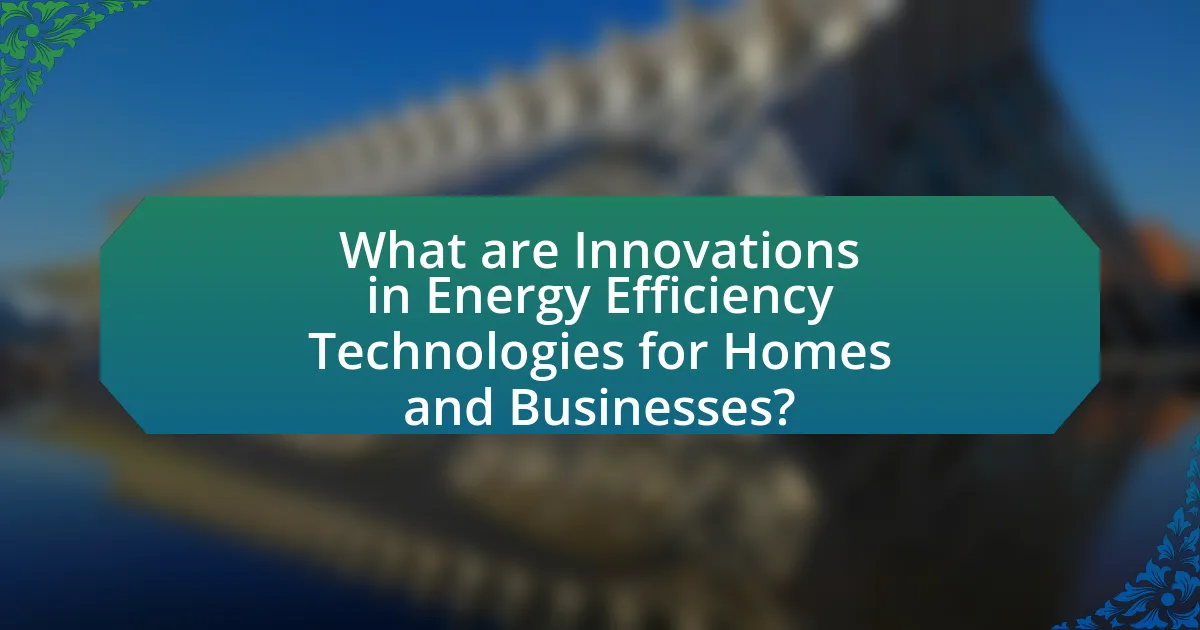
What are Innovations in Energy Efficiency Technologies for Homes and Businesses?
Innovations in energy efficiency technologies for homes and businesses include advanced smart thermostats, energy-efficient appliances, and building automation systems. Smart thermostats, such as the Nest Learning Thermostat, optimize heating and cooling by learning user behavior, leading to energy savings of up to 15% on heating and cooling bills. Energy-efficient appliances, like those certified by ENERGY STAR, consume significantly less energy than standard models, with some appliances using 10-50% less energy. Building automation systems integrate various technologies to monitor and control energy use, resulting in energy savings of 20-30% in commercial buildings. These innovations collectively contribute to reduced energy consumption and lower utility costs, demonstrating their effectiveness in enhancing energy efficiency.
How do these innovations impact energy consumption?
Innovations in energy efficiency technologies significantly reduce energy consumption in homes and businesses. For instance, smart thermostats can optimize heating and cooling systems, leading to energy savings of up to 10-15% annually, as reported by the U.S. Department of Energy. Additionally, LED lighting consumes at least 75% less energy than traditional incandescent bulbs, contributing to lower electricity bills and reduced overall energy demand. These advancements not only enhance energy efficiency but also support sustainability goals by decreasing greenhouse gas emissions associated with energy production.
What specific technologies are considered innovative in this field?
Innovative technologies in the field of energy efficiency for homes and businesses include smart thermostats, energy management systems, and advanced insulation materials. Smart thermostats, such as the Nest Learning Thermostat, utilize machine learning to optimize heating and cooling schedules, resulting in energy savings of up to 15%. Energy management systems, like those offered by Schneider Electric, provide real-time monitoring and control of energy usage, enabling businesses to reduce consumption by 10-30%. Advanced insulation materials, such as aerogel and vacuum insulated panels, significantly enhance thermal performance, reducing energy loss in buildings. These technologies collectively contribute to substantial energy savings and improved sustainability in residential and commercial settings.
How do these technologies differ from traditional energy solutions?
Innovative energy efficiency technologies differ from traditional energy solutions primarily in their ability to reduce energy consumption while maintaining or enhancing performance. Traditional energy solutions often rely on fossil fuels and centralized power generation, leading to higher emissions and inefficiencies. In contrast, innovations such as smart thermostats, energy-efficient appliances, and renewable energy systems utilize advanced algorithms and materials to optimize energy use, resulting in lower operational costs and reduced environmental impact. For instance, according to the U.S. Department of Energy, energy-efficient technologies can reduce energy consumption in homes by 20-30%, demonstrating their effectiveness compared to conventional methods.
Why is energy efficiency important for homes and businesses?
Energy efficiency is crucial for homes and businesses because it reduces energy consumption, leading to lower utility bills and decreased environmental impact. By implementing energy-efficient technologies, such as LED lighting and high-efficiency appliances, households and companies can significantly cut their energy use. For instance, the U.S. Department of Energy reports that energy-efficient upgrades can save homeowners up to 30% on their energy bills. Additionally, energy efficiency contributes to reduced greenhouse gas emissions, helping combat climate change. According to the International Energy Agency, improving energy efficiency could account for over 40% of the emissions reductions needed to meet global climate goals by 2040.
What are the environmental benefits of energy-efficient technologies?
Energy-efficient technologies significantly reduce greenhouse gas emissions, contributing to a healthier environment. By optimizing energy use, these technologies lower the demand for fossil fuels, which are major sources of carbon dioxide and other pollutants. For instance, the U.S. Department of Energy reports that energy-efficient appliances can reduce energy consumption by 10-50%, leading to a decrease in emissions associated with electricity generation. Additionally, energy-efficient buildings can minimize water usage and waste generation, further enhancing environmental sustainability.
How do energy-efficient technologies contribute to cost savings?
Energy-efficient technologies contribute to cost savings by reducing energy consumption, which directly lowers utility bills. For instance, LED lighting uses up to 75% less energy than traditional incandescent bulbs, resulting in significant savings over time. Additionally, energy-efficient appliances, such as Energy Star-rated refrigerators, can save households approximately $200 annually on energy costs. According to the U.S. Department of Energy, implementing energy-efficient measures can lead to savings of 10-50% on energy bills, depending on the technology and usage patterns.
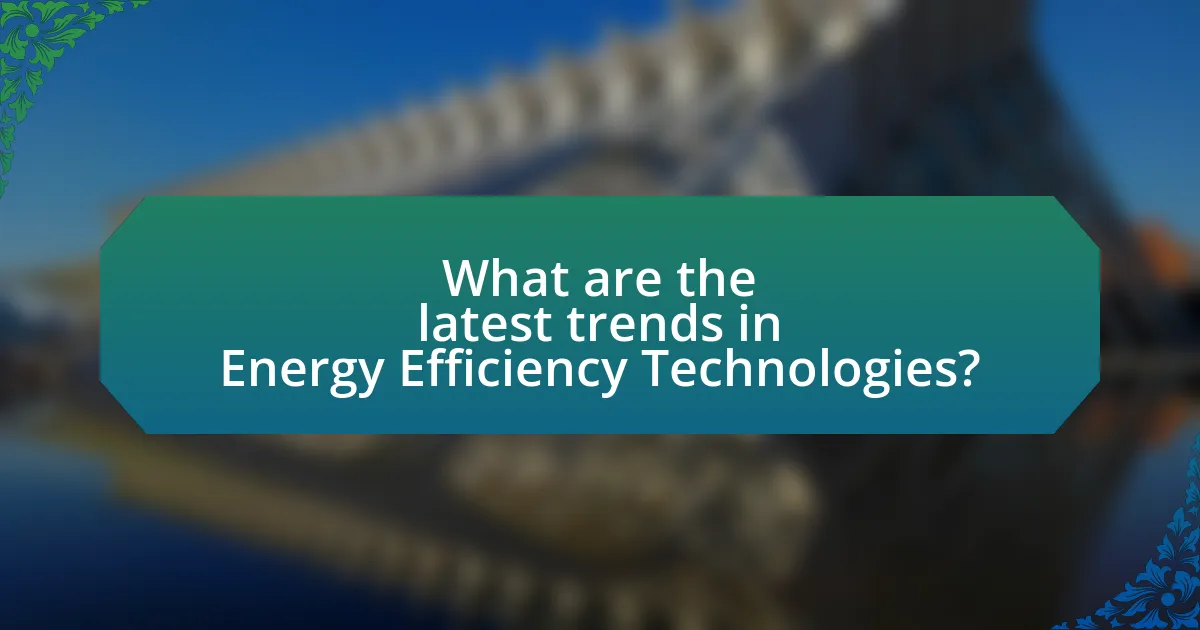
What are the latest trends in Energy Efficiency Technologies?
The latest trends in energy efficiency technologies include the widespread adoption of smart building systems, advanced HVAC systems, and energy management software. Smart building systems utilize IoT devices to optimize energy use by monitoring and controlling lighting, heating, and cooling in real-time, leading to energy savings of up to 30%. Advanced HVAC systems, such as variable refrigerant flow (VRF) systems, provide precise temperature control and can reduce energy consumption by 20-50% compared to traditional systems. Additionally, energy management software enables businesses to analyze energy consumption patterns, identify inefficiencies, and implement targeted strategies for improvement, resulting in an average reduction of 10-15% in energy costs. These trends reflect a growing emphasis on integrating technology to enhance energy efficiency in both residential and commercial settings.
How are smart home technologies enhancing energy efficiency?
Smart home technologies enhance energy efficiency by automating and optimizing energy usage in residential settings. These technologies, such as smart thermostats, lighting systems, and energy monitoring devices, allow homeowners to control and adjust their energy consumption based on real-time data and user preferences. For instance, smart thermostats can learn a household’s schedule and adjust heating and cooling accordingly, resulting in energy savings of up to 10-15% annually, as reported by the U.S. Department of Energy. Additionally, smart lighting systems can automatically turn off when rooms are unoccupied, further reducing unnecessary energy use. Overall, the integration of these technologies leads to more informed energy management and significant reductions in energy waste.
What role do smart thermostats play in energy management?
Smart thermostats play a crucial role in energy management by optimizing heating and cooling systems based on user behavior and environmental conditions. These devices utilize algorithms and sensors to learn user preferences, allowing for automated adjustments that enhance energy efficiency. For instance, a study by the American Council for an Energy-Efficient Economy found that smart thermostats can reduce energy consumption by up to 10-15% annually, translating to significant cost savings for homeowners and businesses. By providing real-time data and remote control capabilities, smart thermostats empower users to make informed decisions about their energy use, further contributing to overall energy management strategies.
How do energy monitoring systems help businesses optimize usage?
Energy monitoring systems help businesses optimize usage by providing real-time data on energy consumption patterns. These systems enable businesses to identify inefficiencies, track usage trends, and implement targeted strategies for energy reduction. For instance, a study by the U.S. Department of Energy found that companies using energy management systems can reduce energy costs by 10-30%. By analyzing this data, businesses can make informed decisions, such as adjusting operational schedules or upgrading equipment, leading to significant cost savings and improved energy efficiency.
What advancements are being made in renewable energy integration?
Advancements in renewable energy integration include the development of smart grid technologies, which enhance the efficiency and reliability of energy distribution. These technologies enable real-time monitoring and management of energy flows, facilitating the incorporation of diverse renewable sources such as solar and wind into existing power systems. For instance, the International Energy Agency reported that smart grids can reduce energy losses by up to 30%, significantly improving overall system performance. Additionally, energy storage solutions, such as advanced battery systems, are being integrated to balance supply and demand, allowing for greater utilization of intermittent renewable resources. According to a report by BloombergNEF, global battery storage capacity is expected to reach 1,000 GWh by 2040, further supporting renewable energy integration.
How do solar panels contribute to energy efficiency in homes?
Solar panels contribute to energy efficiency in homes by converting sunlight into electricity, which reduces reliance on grid power. This process allows homeowners to generate their own energy, leading to lower utility bills and decreased energy consumption from fossil fuels. According to the U.S. Department of Energy, homes with solar panels can save an average of $20,000 over 20 years on energy costs, demonstrating significant financial and environmental benefits. Additionally, solar panels can increase a home’s energy independence, further enhancing overall energy efficiency.
What innovations are emerging in wind energy for businesses?
Emerging innovations in wind energy for businesses include advanced turbine designs, digital twin technology, and energy storage integration. Advanced turbine designs, such as larger and more efficient blades, enhance energy capture and reduce costs. Digital twin technology allows for real-time monitoring and predictive maintenance, improving operational efficiency. Additionally, integrating energy storage systems with wind farms enables businesses to store excess energy for use during low production periods, thus optimizing energy management. These innovations collectively contribute to increased reliability and cost-effectiveness in wind energy solutions for businesses.
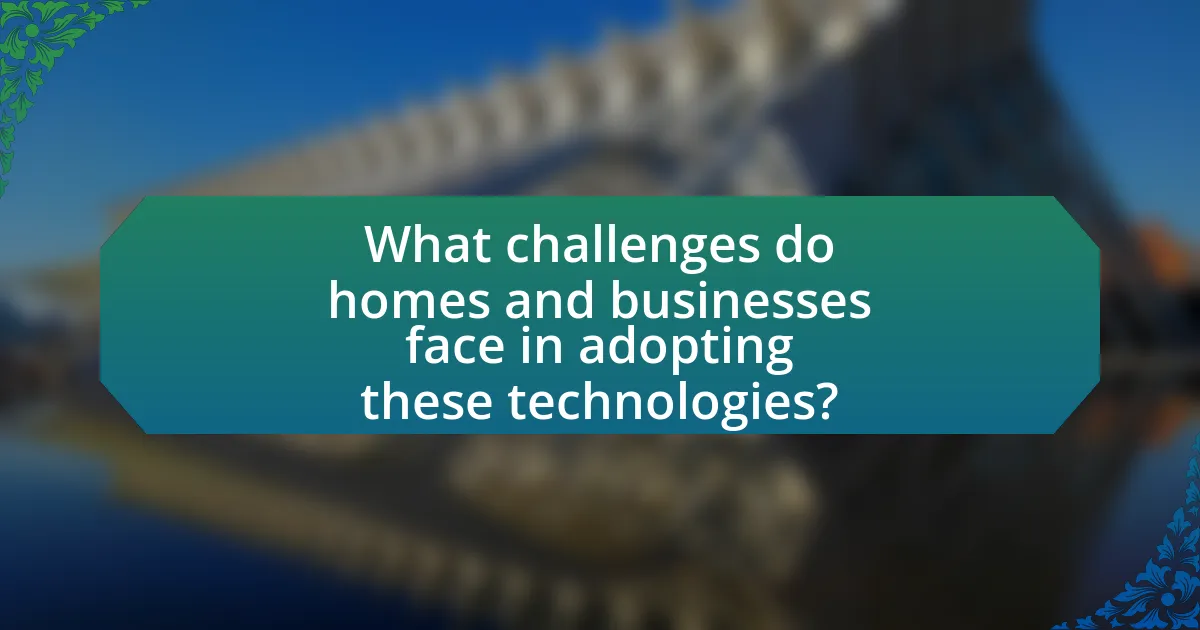
What challenges do homes and businesses face in adopting these technologies?
Homes and businesses face significant challenges in adopting energy efficiency technologies, primarily due to high initial costs and lack of awareness. The upfront investment required for advanced technologies, such as smart thermostats or energy-efficient appliances, can deter adoption, as many consumers and businesses are concerned about return on investment. According to a report by the American Council for an Energy-Efficient Economy, nearly 70% of businesses cite cost as a major barrier to implementing energy-efficient solutions. Additionally, the complexity of these technologies can lead to confusion and resistance, as many users may not fully understand how to integrate them into existing systems. This lack of knowledge can result in underutilization or ineffective implementation, further hindering the transition to energy-efficient practices.
What are the common barriers to implementing energy-efficient solutions?
Common barriers to implementing energy-efficient solutions include high upfront costs, lack of awareness, and insufficient incentives. High upfront costs deter many homeowners and businesses from investing in energy-efficient technologies, despite long-term savings. Lack of awareness about the benefits and availability of these solutions further hampers adoption, as potential users may not understand how energy efficiency can reduce operational costs. Additionally, insufficient incentives from government or utility programs can limit financial support, making it harder for individuals and organizations to justify the initial investment. These barriers collectively hinder the widespread adoption of energy-efficient technologies, despite their potential to significantly reduce energy consumption and greenhouse gas emissions.
How does the initial cost affect adoption rates?
The initial cost significantly impacts adoption rates of energy efficiency technologies. Higher upfront costs can deter potential adopters, as many consumers and businesses prioritize immediate financial outlay over long-term savings. For instance, a study by the American Council for an Energy-Efficient Economy (ACEEE) found that when initial costs are reduced through incentives or financing options, adoption rates can increase by up to 50%. This demonstrates that lowering the initial financial barrier can lead to greater acceptance and implementation of energy-efficient solutions.
What role does consumer awareness play in technology adoption?
Consumer awareness significantly influences technology adoption by informing individuals about the benefits and functionalities of new technologies. When consumers are aware of energy efficiency technologies, such as smart thermostats or energy-efficient appliances, they are more likely to understand their potential cost savings and environmental benefits. Research indicates that informed consumers are 50% more likely to adopt energy-efficient technologies, as they recognize the long-term advantages and return on investment associated with these innovations. This awareness drives demand, encouraging manufacturers to invest in and promote energy-efficient solutions, ultimately accelerating the adoption process.
How can homes and businesses overcome these challenges?
Homes and businesses can overcome challenges in energy efficiency by adopting advanced technologies such as smart thermostats, energy-efficient appliances, and renewable energy sources like solar panels. These innovations enable better energy management and reduce consumption. For instance, a study by the U.S. Department of Energy found that smart thermostats can save homeowners up to 10-12% on heating and cooling costs annually. Additionally, businesses implementing energy-efficient lighting and HVAC systems can reduce energy use by 30% or more, as reported by the Energy Star program. By integrating these technologies, both homes and businesses can significantly enhance their energy efficiency and lower operational costs.
What financial incentives are available for adopting energy-efficient technologies?
Financial incentives for adopting energy-efficient technologies include tax credits, rebates, grants, and low-interest loans. For instance, the federal government offers the Energy Efficient Home Credit, which provides a tax credit for builders of energy-efficient homes. Additionally, many states and local governments provide rebates for energy-efficient appliances and systems, such as HVAC units and insulation. According to the Database of State Incentives for Renewables & Efficiency (DSIRE), over 2,000 financial incentives exist across the United States, promoting the adoption of energy-efficient technologies. These incentives aim to reduce upfront costs and encourage investments in energy efficiency, ultimately leading to lower energy bills and reduced environmental impact.
How can education and training improve technology adoption?
Education and training can significantly improve technology adoption by equipping individuals with the necessary skills and knowledge to effectively use new technologies. When individuals receive targeted education on energy efficiency technologies, they become more confident and competent in implementing these innovations in their homes and businesses. For instance, a study by the American Council for an Energy-Efficient Economy found that training programs can increase the adoption rate of energy-efficient technologies by up to 30%, as participants are better informed about the benefits and functionalities of these technologies. This increased understanding leads to greater acceptance and utilization, ultimately driving widespread adoption.
What are the best practices for maximizing energy efficiency in homes and businesses?
The best practices for maximizing energy efficiency in homes and businesses include implementing energy-efficient appliances, enhancing insulation, utilizing smart thermostats, and adopting renewable energy sources. Energy-efficient appliances, such as those rated by ENERGY STAR, consume less electricity, leading to lower utility bills and reduced environmental impact. Enhancing insulation in walls, attics, and floors minimizes heat loss in winter and heat gain in summer, which can reduce heating and cooling costs by up to 20%. Smart thermostats optimize heating and cooling schedules based on occupancy patterns, further improving energy savings. Additionally, integrating renewable energy sources, like solar panels, can significantly decrease reliance on fossil fuels and lower energy expenses. According to the U.S. Department of Energy, implementing these practices can lead to energy savings of 10-50%, demonstrating their effectiveness in promoting energy efficiency.
How can regular maintenance improve the performance of energy-efficient technologies?
Regular maintenance enhances the performance of energy-efficient technologies by ensuring optimal operation and longevity. For instance, routine checks and servicing of HVAC systems can prevent inefficiencies caused by dirt buildup or mechanical wear, which can lead to energy waste. Studies indicate that well-maintained systems can operate up to 15% more efficiently compared to neglected ones, as highlighted by the U.S. Department of Energy. This efficiency translates to lower energy bills and reduced environmental impact, reinforcing the importance of regular maintenance in maximizing the benefits of energy-efficient technologies.
What strategies can be implemented to encourage energy-saving behaviors?
To encourage energy-saving behaviors, implementing strategies such as providing financial incentives, promoting awareness campaigns, and utilizing smart technology is essential. Financial incentives, like rebates for energy-efficient appliances, have been shown to increase adoption rates; for instance, a study by the American Council for an Energy-Efficient Economy found that such programs can lead to a 10-30% increase in energy savings. Awareness campaigns that educate consumers about the benefits of energy conservation can also significantly impact behavior; research indicates that informed individuals are more likely to adopt energy-saving practices. Additionally, integrating smart technology, such as programmable thermostats and energy monitoring systems, empowers users to track and reduce their energy consumption effectively, leading to an average reduction of 10-15% in energy use, as reported by the U.S. Department of Energy.
